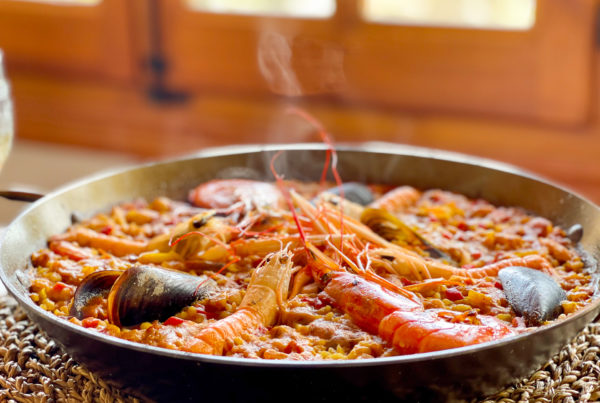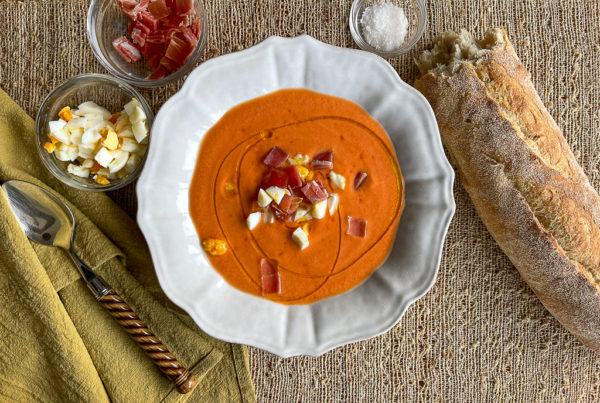Inés Ortega is a food writer and expert in the ins and outs of Spanish cuisine. With her mother Simone Ortega, she co-authored later editions of her book 1080 Recetas, the encyclopedic Spanish cookbook found in almost every household across Spain.
The History of the Tortilla Española and Its Use in Spain
The one, the only Spanish omelet has its origins in the region of Extremadura. This is what expert Javier López Linage attests. His is not just any opinion, as he is nothing less than a scientist from the Center for Human and Social Sciences of the CSIC. Within this acronym hides the Higher Council for Scientific Research, a council which is funded directly by the Government of Spain. In addition, López Linage, PhD, has edited numerous research books, some of them on the potato itself.
He tells us something that he researches to this day: according to the primary source documents that he has found, the conceptual origin of the famous Spanish potato omelet lies in Villanueva de la Serena, during the end of the 18th century.
Potatoes: Cheap Food
Let’s go back in time a little. It is known throughout the world that the potato was not known in Europe until the first Spanish conquerors brought it back from America. But unlike other products such as tobacco or cocoa, it was by no means an instant success. López Linage comments that there were many vicissitudes that this product went through before finding a place at the Spanish dinner table.
For example, there were problems of a botanical nature such as the adaptation of its seeds to the climate and conditions of Spanish land. Likewise, it also had a certain bad reputation at the beginning, since it belongs to the Solanaceae (nightshade) family. Finally, there were also difficulties in its cultivation by farmers.
This expert says that at the beginning of the 17th century, potatoes were already being sold in the Plaza Mayor in Madrid, but “from a culinary point of view it was not very clear what to do with them.”

Deadly nightshade flower
Useful Against Hunger
For many centuries, the potato was considered to be an undervalued produce option, but it proved useful to alleviate the terrible famines of the time. However, it was during 19th century that Spain saw the most serious attempts to make the potato palatable in order to mitigate these frequent famines.
In fact, scientist López Linage can say without any hesitation that, “the potato saved many people from hunger, and also led to the birth of great dishes.”
By chance, the Spanish potato omelet, or Tortilla Española, was born exactly in the region that contributed the most to its arrival to Spain. It is well known as the vast majority of the first great conquerors came from Extremadura.
Historia de la Tortilla de Patata y su uso en España
La única, la irrepetible, la españolísima tortilla de patatas tiene su origen en Extremadura. Así lo asegura el experto Javier López Linage. No es una opinión cualquiera, se trata nada menos que un científico titular del Centro de Ciencias Humanas y Sociales del CSIC. Bajo estas siglas se esconde el Consejo Superior de Investigaciones Científicas, que depende directamente del Gobierno de España. Además, López Linage es doctor en Filosofía y ha editado numerosos libros de investigación, alguno de ellos sobre la papa.
En él cuenta algo que adelanta hoy: según las fuentes documentales que ha encontrado, el origen conceptual de la famosa tortilla de patatas está en Villanueva de la Serena, hacía finales del siglo XVIII.

Alimento barato
Retrocedamos un poco en el tiempo. Conocido es por todo el mundo que la patata no fue conocida en Europa hasta que los primeros conquistadores españoles la trajeron de América. Pero a diferencia de otros productos como el tabaco o el cacao, no fue ni mucho menos un éxito. López Linage comenta que fueron muchas las vicisitudes que atravesó este producto antes de hacerse un hueco en la mesa de los españoles.
Por ejemplo, había un problema de tipo botánico y de adaptación de las semillas al clima y a las condiciones de las tierras españolas. Asimismo, también tuvo al principio cierta mala fama, puesto que pertenece a la familia de las solanáceas. Finalmente, también había dificultades para su cultivo con los propietarios de la tierra.
Este experto cuenta que a comienzos del XVII ya se vendían papas en la Plaza Mayor de Madrid, pero «desde el punto vista culinario no se sabía muy bien qué hacer con ellas».
Útil contra el hambre
Era considerada una solución alimenticia poco valorada culinariamente, pero útil para paliar las terribles hambrunas de la época. Sin embargo, el siglo XIX es el que contempló los ensayos más serios de hacer atractiva la patata para paliar las frecuentes hambrunas de la época.
De hecho, este científico puede afirmar sin ningún tipo de duda que «la patata ha salvado del hambre a mucha gente, y además ha propiciado el nacimiento de grandes platos».
La casualidad ha querido que la tortilla de patatas naciera precisamente en la región que más contribuyó a su llegada a España. Es de sobra conocido como la gran mayoría de los primeros grandes conquistadores procedían de Extremadura.

Extremadura, Spain
Cooked in a Thousand Ways
The history of the potato in Spain is shorter than people think. And much more recent still is the popularity that it has today. “For many years it was eaten mainly cooked, accompanying other foods. French fries, the snacks, which are so popular now, appeared only very recently. The first references that I have in Spain are from the Madrid pubs, which at the end of the 1920s offered potato chips, something similar to current wavy potato chips,” says López Linage.
Tortilla Española: An Uncertain Origin
The origin of the Spanish potato omelet is not very clear. On the one hand, as documented by The Chronicles of the Indies, we know that the first omelets were common knowledge both by the Spanish and the Aztecs around the year 1519. And additionally, we know that Pizarro brought potatoes from America to Europe in 1537 as food for animals. The Spanish often confused potatoes, “patatas,” with sweet potatoes (in Spanish “batatas” from the original Taíno) around the year 1519 due to their similar appearance. The name “batata” led to Spaniards calling potatoes “patatas,” keeping that name until today, with the exception of the Canary Islands and part of Andalusia that continues to call them “papas,” in similarity to the rest of the Spanish-speaking countries.
Until recently, the first known document in which reference was made to the Spanish omelet was a letter dated 1817 addressed to the Cortes of Navarra in which it was said that the inhabitants of Pamplona consumed: two or three eggs in an omelet with five or six mixing potatoes, bread, etc. Others suggest that the invention should be attributed to the Belgian chef Lancelot de Casteau, who published the recipe in 1604 and who worked as a cook for three bishops of Liège.
Preparing a Spanish omelet is a challenge that anyone who likes to cook must eventually face, so you should know that making a Spanish omelet is simple, but making a good Spanish omelet is not.
Should a business school teach its students how to make a Spanish potato omelet?
It is an extravagance, but it is one of the things that students of Business Administration and Management and International Relations learn at Schiller International University, an American institution, which has one of its campuses in Madrid. And there is a reason for it.
“Technology breaks down physical barriers, but not cultural ones,” says José B. Pinto, professor of a subject that bears the name ‘Multicultural competence for doing business’. “To close a deal,” he assures, “it is necessary to know the cultures of the person with whom you are working: and food is a fundamental aspect.”
Cocinada de mil formas
La historia de la papa es en España más corta de lo que la gente piensa. Y mucho más reciente todavía es la popularidad con la que ahora cuentan. «Durante muchos años se tomó fundamentalmente cocida, acompañando a otros alimentos. Las patatas fritas, entendidas como snacks y que tan populares son ahora, aparecieron hace muy poco. Las primeras referencias que yo tengo en España son de las cervecerías de Madrid, que a finales de los años 20 ofertaban virutas fritas de patata, algo parecido a las actuales patatas de esas onduladas», afirma este investigador.
Un origen incierto
El origen de la tortilla de patata no está muy claro. Por un lado, según documentan Las Crónicas de Indias, sabemos que las primeras tortillas de huevos, se conocen entorno al año 1519, tanto por los españoles como por los aztecas. Y por otro lado, sabemos que las patatas las trajo Pizarro de América a Europa en el año 1537 como alimento para los animales. Los españoles confundían las papas con las batatas debido a su parecido aspecto y es por ello que las empiezan a llamar patatas adoptando ese nombre hasta hoy en día, excepto en Canarias y parte de Andalucía que las siguen llamando papas, igual que en el resto de los países hispanohablantes…
Hasta hace poco el primer documento conocido en el que se hacía referencia a la tortilla de patatas era un escrito datado en 1817 dirigido a las Cortes de Navarra en el que se hablaba de que los habitantes de Pamplona consumían: dos o tres huevos en tortilla para cinco o seis mezclando patatas, pan, etc. Otros proponen que la invención se le debería atribuir al cocinero belga Lancelot de Casteau, que publicó la receta en 1604 y que trabajó como cocinero de tres obispos de Lieja.
Preparar una tortilla de patata es un reto al que todo aquel que le guste cocinar se debe enfrentar, pero debe saber que hacer una tortilla de patata es sencillo pero hacer una buena tortilla de patata no lo es.
¿Debe una universidad orientada a los negocios enseñar a sus alumnos a hacer una tortilla de patata?
Resulta una extravagancia, pero es una de las cosas que aprenden los alumnos de Administración y Dirección de Empresas y Relaciones Internacionales de la Schiller International University, una institución estadounidense, que tiene uno de sus campus en Madrid. Y hay una razón para ello.
“La tecnología rompe las barreras físicas, pero no las culturales”, comenta José B. Pinto, profesor de una asignatura que lleva como nombre ‘Competencia multicultural para hacer negocios’. Para cerrar un trato, asegura, es necesario conocer las culturas de la persona con la que estás trabajando: y la comida es un aspecto fundamental.




